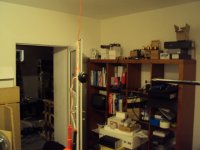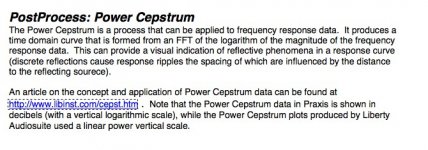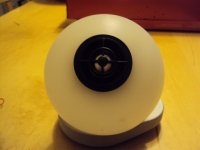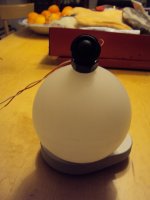Hi Joachim,
I would prefer this one over the TB. Check latest Hobby Hifi. Pretty amazing unit I'd say.
The front plate is diecast metal. Not so easy to process as plastic. But on the Madisound site (scroll down) it looks as if you might be able to remove it (or the whole thing then falls apart ).
).
Oliver
I would prefer this one over the TB. Check latest Hobby Hifi. Pretty amazing unit I'd say.
The front plate is diecast metal. Not so easy to process as plastic. But on the Madisound site (scroll down) it looks as if you might be able to remove it (or the whole thing then falls apart
Oliver
Yes, Oliver, i am interested in that one too and have the Hobby HiFi issue.
I have talked to Gerd Lommersum ( ASE - Acoustic Systems Engineering ) and he actually prefers the VIVA OX i have chosen, nevertheless i think this tweeter will sound different not the least because of the hard membrane material.
I will order two.
I have talked to Gerd Lommersum ( ASE - Acoustic Systems Engineering ) and he actually prefers the VIVA OX i have chosen, nevertheless i think this tweeter will sound different not the least because of the hard membrane material.
I will order two.
Hello,
"wide dispersion" Yes.
"low diffraction" certainly Not ! For example, the midrange wavefield is diffracted from the tweeter tube, and vice versa. High diffraction allows for wide dispersion.
Interesting is to think how important is 'low diffraction' anyway from the perception point of view. Human do not hear diffraction as such (well, ok there is the HRTF ). Sometimes diffraction can be your friend if it allows to achieve a design goal
). Sometimes diffraction can be your friend if it allows to achieve a design goal 
- Elias
"wide dispersion" Yes.
"low diffraction" certainly Not ! For example, the midrange wavefield is diffracted from the tweeter tube, and vice versa. High diffraction allows for wide dispersion.
Interesting is to think how important is 'low diffraction' anyway from the perception point of view. Human do not hear diffraction as such (well, ok there is the HRTF
- Elias
Hi,
To get back to the topic of low diffraction and / or wide dispersion speakers
I guess SL's Pluto should be mentioned. It doesn't do it to the highest treble,
but its certainly a "low diffraction" "wide dispersion" design, is it not ?
PLUTO-2.1 omni-directional loudspeaker
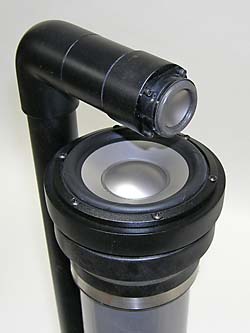
Don't discuss it here, that not the point, but for those interested
the "Concepts" section might be interesting background reading.
rgds, sreten.
Hello,
"wide dispersion" Yes.
"low diffraction" certainly Not ! For example, the midrange wavefield is diffracted from the tweeter tube, and vice versa. High diffraction allows for wide dispersion.
<snip>
- Elias
 Hello,
Hello,Be careful with your assumptions! What tube?
Diffraction = Change in the directions and intensities of a group of waves after passing by an obstacle or through an aperture whose size is approximately the same as the wavelength of the waves.
If the obstacle is the baffle, it is being minimized.
The edges are being softened.
Diffusion is being maximized.
Diffraction is being minimized.
BTW This not about the Pluto.
DT
All just for fun!
The edges are being softened.
Diffusion is being maximized.
Diffraction is being minimized.
BTW This not about the Pluto.
Hello,
"wide dispersion" Yes.
"low diffraction" certainly Not
OT on
Hi Guys,
I agree with DT. The xover is 1KHz for Pluto. So the tube is acoustically small (lambda F/7 and smaller). Thus "deflection" might be the better term.
OT off
Oliver
I have now measured the OX tweeter and the 19TFF with conventional frontplate hanging on a string. There is really no contest. Please look. The window was set at 4msec. I do measure reflexions with Power Cepstrum analysys. See me next post.
Attachments
I will build the midrange in a Nylon sphere. A volume of 3 liters should work. With a first order xover and impedance control a 2nd order Linkwitz is posible acoustically.
May years ago i had already experimented with spheres. At that time i put a tweeter into it. The ZDL will be more extrem. The tweeter needs no aditional cabinet. See my mockup.
The sphere shown is too small though.
The output of the midrange in the passband under thoose conditions is ca. 103 dB @ 1m without the coil leaving the gap.
May years ago i had already experimented with spheres. At that time i put a tweeter into it. The ZDL will be more extrem. The tweeter needs no aditional cabinet. See my mockup.
The sphere shown is too small though.
The output of the midrange in the passband under thoose conditions is ca. 103 dB @ 1m without the coil leaving the gap.
Attachments
OK, i will keep the colours the same next time. My measurent system asigns the colours automatically and i did not edit. Yes, from the back the OX tweeter has even a bit more treble then from 90°.What that experiment has shown is, that when the tweeter is small enough reflexions are very low up to high frequencies. There is of cause some beaming from the finite size of the membrane and the soft membrane breaking up in the higher treble.
Seems to be very well controlled though, and the first 0.4msec are superbly clean on the cepstrum plot.
Here is the woofer i will use. It will work in a closed, reflex or transmission line box.
I am not sure what to do. I made my last transmission line 27 years ago but that could be interesting. I have AJ Horn that can simulate transmission lines but i did not use that programm much. I usually do everything in LSP-CAD.
Seems to be very well controlled though, and the first 0.4msec are superbly clean on the cepstrum plot.
Here is the woofer i will use. It will work in a closed, reflex or transmission line box.
I am not sure what to do. I made my last transmission line 27 years ago but that could be interesting. I have AJ Horn that can simulate transmission lines but i did not use that programm much. I usually do everything in LSP-CAD.
Attachments
 Hello Joachim,
Hello Joachim,That is an interesting woofer you have selected. It is not the most expensive and i am sure you selected it for quality. Please share the features you were looking for.
If you are not sure TL, reflex ... The Qtc is 0.51, fairly high and a pair may work dipole. Just a thought.
DT
All just for fun!
DT, it is late here so i answer quick with more tomorrow. This woofer works in a TL of ca. 2m. This gives a little under 50 Hz -3dB and i found that not too impressive. In a reflex of 100 Liter it works well with a -3dB under 30 Hz. It woud work in a Dipole too but i decided on a cabinet out of varios resons. In my big systen i have 4 of the 30cm version playing in
push-pull M Dipoles and the bass i get is fantastic. Very high speed with a lot of punsh but in the ZDL i will try to make the best from the reflex principle.
push-pull M Dipoles and the bass i get is fantastic. Very high speed with a lot of punsh but in the ZDL i will try to make the best from the reflex principle.
Here are the cepstrum plots. If you have questions, ask me.
Hi Joachim,
I haven't done cepstrum plots myself yet, but understand the basics. Could you tell us something about the sources of reflection (attributed to the time scale), that make up the differences between both plots? It would help me to understand how valuable this method is in real life.
In your linked essay "Reflecting on Echoes ..." I found a reference to the very interesting work of McEachern. Do you know by any chance where I could get his "Hearing it like it is ..." article? Goggle did result in 1000 references, but no source to obtain a copy.
Rudolf
- Status
- This old topic is closed. If you want to reopen this topic, contact a moderator using the "Report Post" button.
